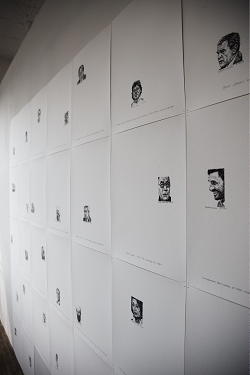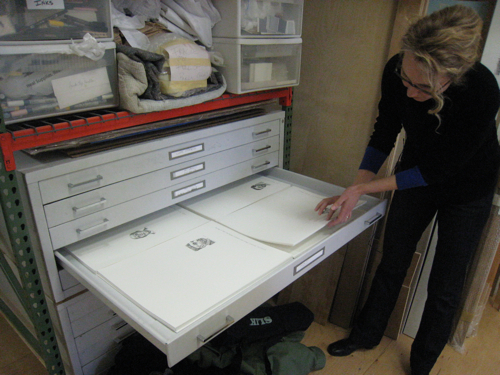1stfans Twitter Art Feed Artist for February 2009: Mary Temple
We all know this feeling, right? When you walk into an exhibition and there’s one work that really stops you in your tracks? On a recent trip to Pittsburgh, it happened to me at the Mattress Factory‘s Inner and Outer Space exhibition. I was fascinated with a work by Mary Temple, a Brooklyn-based artist, that was installed on the MF’s 5th floor.

Installation view, courtesy Mattress Factory.
Every day, as Mary was reading the day’s news via various news sites on the internet, she would select a political figure to draw on a tabloid sized sheet of paper. Each day, she would scan the drawing, send to the MF where they would print and hang it in the gallery in a calendar style format on the walls. I spent a long time pouring over the walls of the exhibition space and left wanting to follow this project day-by-day, but knew that I wouldn’t be able to.
When Will and I first conceptualized the 1stfans Twitter Art Feed, this project of Mary’s was one of the first works that came to my mind. Could we figure out a way to bring this project into the feed and tweet each day with a link to the drawing? I knew that the MF show was closing in mid-January and wondered if a continuation could take place online for the 1stfans, so a quick call to Jeffrey at MF was in order and the next day I was e-mailing Mary (thanks, Jeff).

Mary Temple has been working on this series since 2007 and drawings are archived in stacks by month in flat files that reside in her Brooklyn studio.
This has been an incredibly fun collaboration for us on many levels. In reaching out to the artist, it was our chance to work with the MF and they’ve also given us some video footage of the process that will be up soon. For Mary, we developed a way to display the drawings in calendar-format, so the virtual presentation will mirror the layout in the gallery with an added Twitter twist. 1stfans will be able to follow day-by-day, then everyone will be able to see the work in our own galleries because we will be installing the work for one night only at the March 7th Target First Saturday. You can follow along by joining 1stfans and we hope to see you there!
I’ll leave you reading Mary’s own narrative about the work:
Mary Temple
Currency
2007-present
On September 24, 2007 the president of Iran spoke at Columbia University amid protests and much controversy. I found the event, coverage and images of Mahmoud Ahmadinejad compelling and made some drawings of him from various Web–based news sources. The drawings piqued my interest in him as a character—I wanted to know more about his history as well as Iran’s past. Drawing him expanded my thinking about world events. I’ve continued to make a drawing of a world leader every day since then. My goal in the beginning was simply to concentrate on one event each day—to try to grasp a minuscule portion of the barrage of information that surrounds each of us in a 24-hour news cycle. As the research and drawings accumulated, I found that the news events marked my own personal history as well as delineating a (biased) global event time line. In order to underscore that relationship, and the diaristic nature of the undertaking, I hung the drawings in a calendar format—7 day (columns) across, and 5 to 6 week (rows) down. I placed the drawings on the page according to my own feelings of optimism or pessimism regarding the day’s event, the higher on the page the greater my hope for world harmony.
Each evening I select a story and the character (a world leader), draw a portrait in pen and ink on a tabloid size sheet of paper, and record the event with an image caption at the bottom of the page. The drawing is then scanned and emailed to a museum. Every morning the museum staff receives my email scan, prints the portrait on a similar tabloid size sheet of handmade paper and hangs it in a gallery next to the previous day’s drawings in the calendar grid. Entire calendar years accumulate in this way.
The title, of the piece, Currency, most obviously references my desire and attempt to keep current of world events, to try to understand some of what is happening in the world. It also refers to something that fascinates me about an industry that trades in a product that is only valuable until the moment it is heard, at which time it instantly loses its value. Yesterday’s news is an artifact which no longer has currency or power as a trade worthy item. The title Currency also refers to the scale of the portraits themselves, which might evoke a bank note or dollar bill portrait, the image of power and money entwined.
—
The 1stfans Twitter Art Feed is no longer a benefit of 1stfans membership, but the original feed in its entirety has been archived on the Brooklyn Museum website.

Shelley Bernstein is the former Vice Director of Digital Engagement & Technology at the Brooklyn Museum where she spearheaded digital projects with public participation at their center. In the most recent example—ASK Brooklyn Museum—visitors ask questions using their mobile devices and experts answer in real time. She organized three award-winning projects—Click! A Crowd-Curated Exhibition, Split Second: Indian Paintings, GO: a community-curated open studio project—which enabled the public to participate in the exhibition process.
Shelley was named one of the 40 Under 40 in Crain's New York Business and her work on the Museum's digital strategy has been featured in the New York Times.
In 2016, Shelley joined the staff at the Barnes Foundation as the Deputy Director of Digital Initiatives and Chief Experience Officer.
